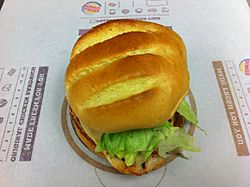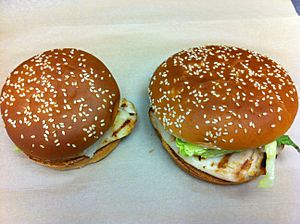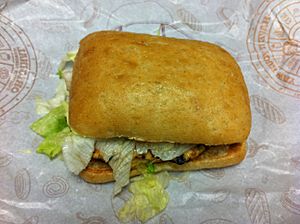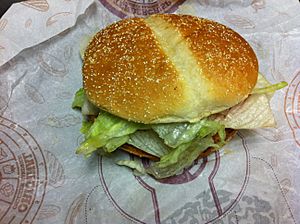Burger King grilled chicken sandwiches facts for kids

The North American version of the
TenderGrill sandwich, as of November 2013. |
|
| Nutritional value per 1 sandwich (425 g) | |
|---|---|
| Energy | 510 kcal (2,100 kJ) |
|
49 g
|
|
| Sugars | 15 g |
| Dietary fiber | 0 g |
|
19 g
|
|
| Saturated | 3.5 g |
| Trans | 0.5 g |
|
Protein
|
37 g
|
| Minerals | Quantity
%DV†
|
| Sodium |
79%
1180 mg |
| Other constituents | Quantity |
| Energy from fat | 124 kcal (520 kJ) |
| Cholesterol | 75 mg |
|
May vary outside US market.
|
|
| †Percentages estimated using US recommendations for adults. Source: www.BK.com (PDF) |
|
Did you know that Burger King was the first big fast-food chain to sell a grilled chicken sandwich? They did it in 1990! This was six months before Wendy's and four years before McDonald's. Since then, Burger King and its Australian partner, Hungry Jack's, have offered many kinds of grilled chicken sandwiches. Wendy's and McDonald's also have their own versions.
Burger King's first grilled chicken sandwich was called the BK Broiler. It was super popular! Later, it changed names to the Chicken Whopper in 1992, named after their famous Whopper sandwich. In 2004, the BK Baguette took its place, which was meant to be a healthier choice. Then, in 2005, the TenderGrill sandwich came along. It was bigger and had more meat, made for older customers. Burger King sells different types of these sandwiches in different places. Some use white chicken breast, while others use dark chicken thigh meat.
Contents
History of Grilled Chicken Sandwiches
The BK Broiler
Burger King first launched its grilled chicken sandwich, the BK Broiler, in 1990. It came with lettuce, tomato, and a special dill ranch sauce on an oat-dusted roll. Back then, most chicken items at fast-food places were fried.
The BK Broiler was a huge hit! Within a month, Burger King was selling over a million of them every day. This even took sales away from fried chicken places like Kentucky Fried Chicken. This sandwich was part of a trend where restaurants started offering healthier options, like salads and different cooking methods. The BK Broiler had 379 calories and 18 grams of fat, with 10 grams from the sauce.
The success of the BK Broiler was one of the best new product launches ever for a restaurant. It made Burger King want to create even more successful items. The sandwich helped Burger King's profits grow a lot. However, by 1992, sales of the BK Broiler had slowed down. In 1998, Burger King made the BK Broiler bigger, along with other sandwiches. The idea was to make customers feel like they were getting more for their money.
The Chicken Whopper
In 2002, Burger King celebrated the 45th birthday of its Whopper sandwich. To mark the occasion, they brought out an updated grilled chicken sandwich called the Chicken Whopper. They also added a smaller version, the Chicken Whopper Jr. sandwich. This was the first time Burger King used the Whopper name for something other than a beef burger.
These sandwiches had a whole chicken breast filet, mayonnaise, lettuce, and tomato on a sesame seed roll. The larger sandwich had a 4.7-ounce (133-gram) filet, and the Jr. had a 3.1-ounce (88-gram) filet. Burger King also introduced a new low-fat mayonnaise with these sandwiches. The Chicken Whopper Jr. was even praised by the Center for Science in the Public Interest as one of the healthier fast-food options.
Burger King started developing the Chicken Whopper in 2001. They found that customers wanted more choices. They also wanted to compete with newer, fancier fast-food places. By July 2002, they had sold almost 50 million Chicken Whoppers! This made it Burger King's best-selling new product ever, even more successful than the BK Broiler's launch.
Even though it started strong, some people felt the excitement for the Chicken Whopper faded after about a year. However, as of 2013, the Chicken Whopper was still the main grilled chicken sandwich sold by Burger King in the Middle East. When Burger King opened in India in 2014, the Chicken Whopper was one of the three Whopper options available.
The BK Baguette
In 2003, Burger King introduced its BK Baguette sandwiches. These were meant to replace the Chicken Whopper. The company wanted these sandwiches to be a lower-fat option, with 5 grams of fat and 350 calories or less. They were designed to get their flavor from fresh ingredients, not from fat.
The baguette sandwiches also came to Europe, starting in the UK in 2003. They had different kinds to suit local tastes. While these sandwiches were popular, some groups in Britain raised concerns about the amount of fat and salt in them. For example, in 2005, the British Food Standards Agency pointed out high levels of fat and salt in some of Burger King's baguette sandwiches. In 2007, a group called Consensus Action on Salt and Health (CASH) also criticized Burger King for the high sodium levels in their foods. They said the Chicken BLT Baguette, with fries and a soda, was one of the saltiest fast-food meals in the UK.
The TenderGrill
The Baguette sandwiches didn't become as popular in the American market. So, in 2005, Burger King stopped selling them there. They were replaced by the TenderGrill sandwich as part of a menu update.
The Grilled Chicken Sandwich
In 2017, Burger King changed its grilled chicken sandwich again. They simply called it the Grilled Chicken Sandwich. This new version used a potato roll instead of a brioche bun and had a new seasoned chicken filet. However, it was stopped in 2019.
Other Grilled Chicken Sandwiches
Other fast-food chains have also created their own grilled chicken sandwiches since 1990. Even though many companies now have them, Burger King was the first national chain to offer a grilled chicken sandwich. They beat Wendy's by several months. Wendy's introduced their first grilled chicken sandwich in August 1990. It had grilled chicken, lettuce, tomato, and honey mustard sauce on a bun. Wendy's updated their sandwich in 1996 and again in 2004, calling it the Ultimate Chicken Grill. This is still Wendy's main grilled sandwich in the United States.
McDonald's took longer to introduce their grilled chicken sandwich. Their kitchens needed new equipment to make a good quality grilled chicken. McDonald's finally launched its version, the McGrilled Chicken Classic, in 1994. This was replaced by the Grilled Chicken Deluxe in 1996, which was part of McDonald's "upscale" sandwich line. However, the Deluxe line didn't sell well, and the Grilled Chicken Deluxe was removed in 1998. McDonald's brought back the Chicken McGrill in 1999. In 2005, the Chicken McGrill was replaced by McDonald's new Premium line of products, which used better ingredients like real cheese and whole leaf lettuce. In 2015, McDonald's changed its grilled chicken sandwich again to the Artisan Grilled Chicken. This new chicken uses fewer ingredients, making it simpler and more natural, which is what many customers want today.
Advertising Grilled Chicken
Burger King once had ads called @BK, love is guaranteed. These ads promised customers a free sandwich if they didn't "love" the Whopper or Chicken Whopper. In 2003, Burger King changed some of its ads to include the Chicken Whopper. They wanted to remind people that the Whopper also came in a chicken version, not just beef.
The BK Baguettes were advertised in the United States with the slogan "Flavor from grilling not fat." These ads featured famous chefs visiting places like farmers' markets. The chefs would talk about how fresh ingredients made the new Baguette sandwiches healthier and tastier.
In 2010, an ad campaign for the TenderGrill sandwich in Spain was very funny. It asked men what kind of advertisement would make them buy the sandwich. Their answers, which included things like barbarians, ninjas, and unicorns, were used to create a humorous ad made entirely by women. In 2011, Burger King in Singapore ran an ad that challenged McDonald's new Chicken McGrill sandwich. Burger King used McDonald's slogan, "Make it better," and changed it to "Make it even Better." They sold their TenderGrill sandwich for just SGD$1.00 on the same day McDonald's new product came out. Burger King even called McDonald's item "fake grilled" compared to their own "flame grilled" chicken.




